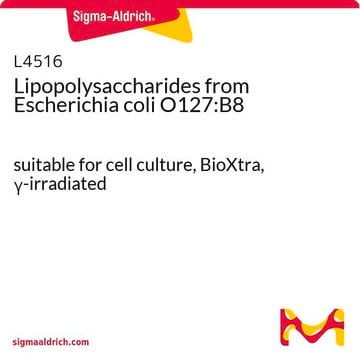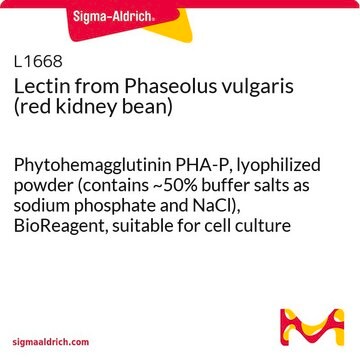推薦產品
product name
脂多糖,大肠埃希菌O111:B4, Lipopolysaccharide, E. coli O111: B4 stimulates the activity of inducible nitric oxide synthase. Induces apoptosis in mouse thymus and swine lymphocytes
品質等級
形狀
lyophilized
製造商/商標名
Calbiochem®
儲存條件
OK to freeze
雜質
≤2.0% Protein
≤2.5% nucleic acid
運輸包裝
ambient
儲存溫度
2-8°C
一般說明
内毒素脂多糖可启动多种生化细胞激活途径(PKC,cAMP依赖性蛋白激酶,花生四烯酸代谢,蛋白豆蔻酰化和G蛋白激活)。为了阐明和定义内毒素休克的相关病理生理参数,已经对这些独特的大分子进行了广泛的研究,内毒素休克是脓毒症威胁生命的严重后果。最近,这些细菌产物由于其多能免疫刺激活性而引起了强烈的兴趣,表现为宿主细胞(例如B淋巴细胞,巨噬细胞)对功能分化的激活。脂多糖激活的宿主细胞产生一系列激素活性淋巴因子和单核因子,包括干扰素(α,β和γ),白介素(IL-1和IL-6),肿瘤坏死因子,血小板活化因子和促凝组织因子。刺激诱导型一氧化氮合酶的活性。诱导小鼠胸腺和猪淋巴细胞凋亡。
刺激诱导型一氧化氮合酶的活性。诱导小鼠胸腺和猪淋巴细胞凋亡。
生化/生理作用
主要靶标
诱导型一氧化氮合酶
诱导型一氧化氮合酶
产物不与ATP竞争。
可逆:否
细胞渗透性:否
警告
毒性:有害(C)
準備報告
为了完全溶解,可能需要将溶液加热至37°C,并间歇涡旋或超声处理。
重構
在复溶后存放于冰箱(4°C)。储备液在 4°C 条件下可稳定保存 6 个月。
其他說明
Hattori, S., et al. 1995.Biochem.Mol.Biol. Int. 35, 177.
Mayeux, P.R., et al. 1995.Biochem.Pharmacol.49, 115.
Norimatsu, M., et al. 1995.Infect.Immun.63, 1122.
Feinstein, D.L., et al. 1993.J. Neurochem.60, 1945.
Zhang, Y.H., et al. 1993.Infect.Immun.61, 5044.
Jackson, S.K., et al. 1992.Biochim.Biophys.Acta1135, 165.
O′Sullivan, M.G., et al. 1992.J. Biol. Chem.267, 14547.
Watanabe, K., et al. 1992.J. Cell.Physiol.150, 433.
Morrison, D.C., and Ryan, J.L.1987.Annu.Rev. Med.38, 417.
Mayeux, P.R., et al. 1995.Biochem.Pharmacol.49, 115.
Norimatsu, M., et al. 1995.Infect.Immun.63, 1122.
Feinstein, D.L., et al. 1993.J. Neurochem.60, 1945.
Zhang, Y.H., et al. 1993.Infect.Immun.61, 5044.
Jackson, S.K., et al. 1992.Biochim.Biophys.Acta1135, 165.
O′Sullivan, M.G., et al. 1992.J. Biol. Chem.267, 14547.
Watanabe, K., et al. 1992.J. Cell.Physiol.150, 433.
Morrison, D.C., and Ryan, J.L.1987.Annu.Rev. Med.38, 417.
法律資訊
CALBIOCHEM is a registered trademark of Merck KGaA, Darmstadt, Germany
訊號詞
Danger
危險聲明
危險分類
Acute Tox. 2 Oral
儲存類別代碼
6.1A - Combustible acute toxic Cat. 1 and 2 / very toxic hazardous materials
水污染物質分類(WGK)
WGK 3
閃點(°F)
Not applicable
閃點(°C)
Not applicable
分析證明 (COA)
輸入產品批次/批號來搜索 分析證明 (COA)。在產品’s標籤上找到批次和批號,寫有 ‘Lot’或‘Batch’.。
客戶也查看了
Zhan Zhao et al.
Journal of neuroinflammation, 17(1), 64-64 (2020-02-20)
Sepsis-associated acute brain inflammation, if unresolved, may cause chronic neuroinflammation and resultant neurodegenerative diseases. However, little is known how the transition from acute to chronic neuroinflammation, which is critical for the following progressive neurodegeneration, occurs in sepsis. The goal of
我們的科學家團隊在所有研究領域都有豐富的經驗,包括生命科學、材料科學、化學合成、色譜、分析等.
聯絡技術服務





